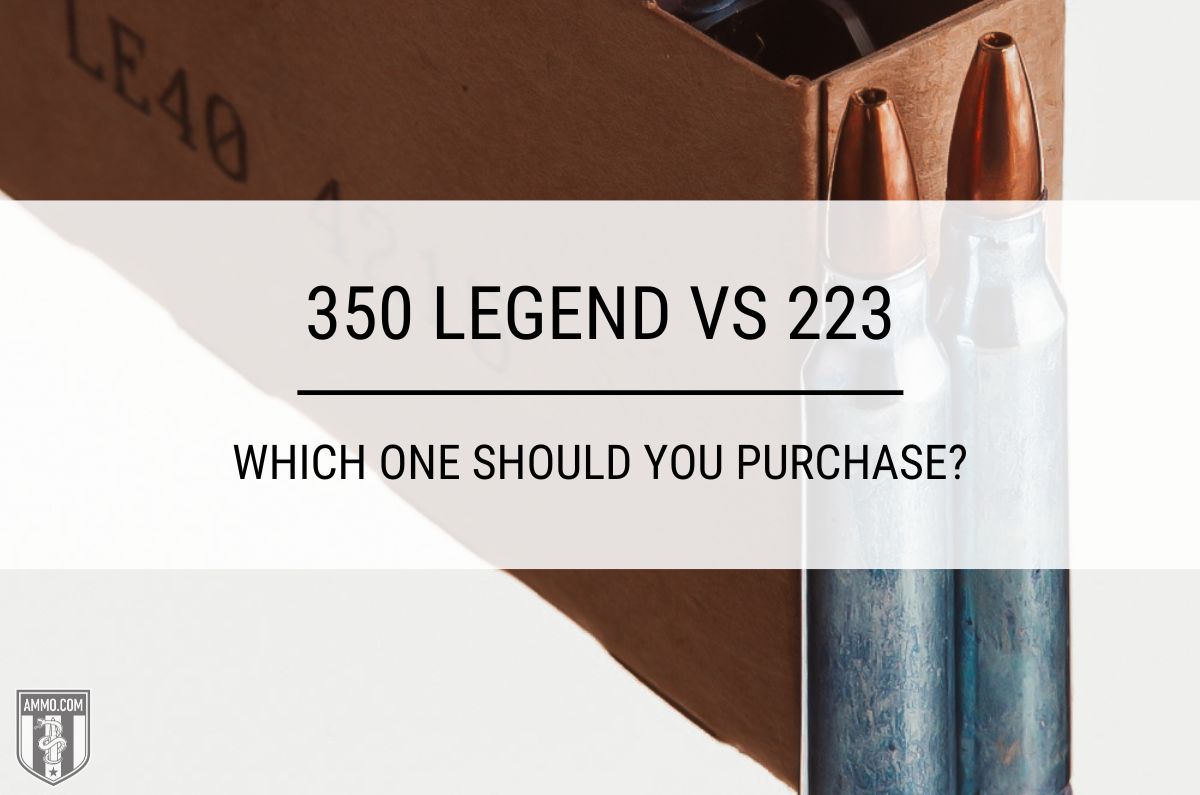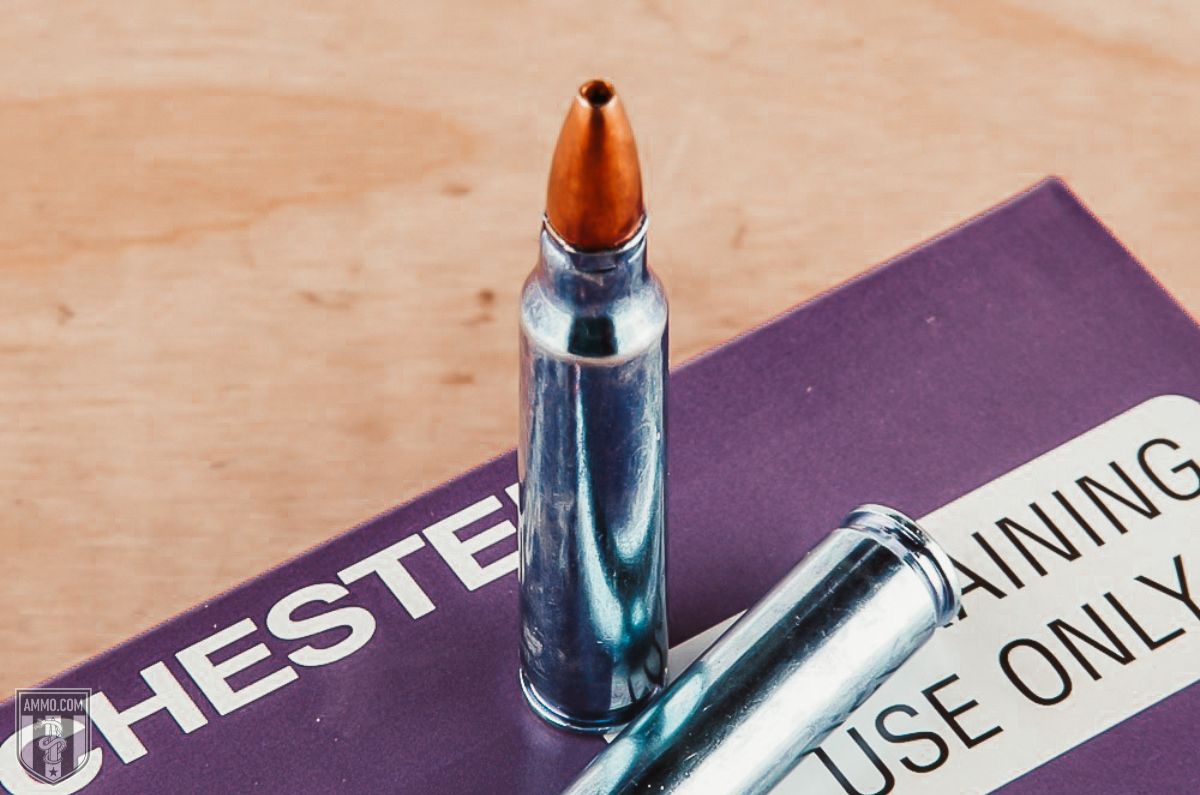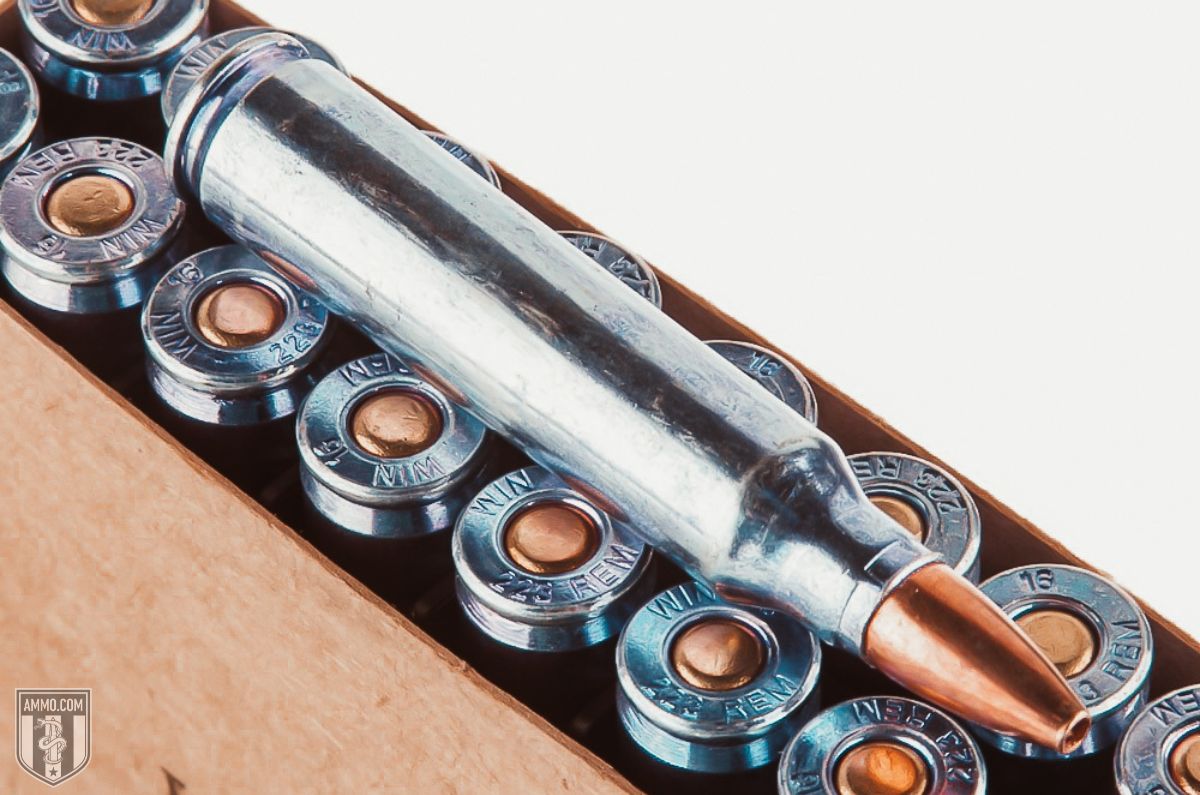
The .223 Rem and 350 Legend were created for two different purposes, yet when you compare the 350 Legend vs 223 side-by-side, they have a few strikingly similar characteristics that allow these calibers to overlap in their intended uses partially.
Below we compare the calibers in several categories that the average shooter will find essential.
If you can’t wait, the .223 Remington won 5/10 sections and is the overall winner for most shooters.
However, if you’re a deer hunter in a state that only allows straight-walled cartridges, the 350 Legend should be your choice.
If you’re ready to see which sections it prevailed in, keep scrolling!
There are several noticeable differences when you look at 350 Legend and .233 Remington rounds next to each other.
First, you’ll see the 350 Legend is a straight-walled cartridge, and the 223 Rem is not. Next, you’ll notice how much more aerodynamic the .223 Rem bullet looks compared to the 350 Legend bullet.
Lastly, you’ll also notice how much larger the 350 Legend bullet is than the 223 bullet.
While we can pick all this up from glancing at the rounds, let’s take a closer look at the dimensions of each cartridge because though there are glaring differences, there are also some shocking similarities.
The .223 Remington and 5.56x45mm NATO have identical case dimensions. However, they are not interchangeable calibers. You can shoot a 223 round through a firearm chambered for 5.56, but you cannot shoot a 5.56 through a rifle chambered for 223 due to differing chamber pressures and freebore length.
To be clear, we are only discussing the 223 in this article.
The 350 Legend cartridge is a unique design and doesn’t have a parent cartridge, while the .222 Remington is the parent case for the 223 cartridge.
The bullet diameter is a clear difference between the two rounds; the 350 Legend has a bullet diameter of 0.357 – 0.003 in, while the smaller bullet diameter of the 223 is 0.224 in.
 As you would expect, since the bullets are different sizes, the neck diameter is also very different; the 350 Legend neck diameter is 0.378 in, and the 223 is 0.253 in.
As you would expect, since the bullets are different sizes, the neck diameter is also very different; the 350 Legend neck diameter is 0.378 in, and the 223 is 0.253 in.
Because the 350 Legend and 223 Remington have the same rim diameter, 0.378” (not listed), integrating the 350 Legend into the AR-15 platform only requires a quick barrel change.
The 223 base diameter is 0.376 in, while the 350 Legend is 0.390 in. The case length is slightly different, with the 223 case being 1.76 in and the 350 Legend case being 1.71 in.
The overall length of each cartridge is another similarity; the 350 Legend has an overall length of 2.25 in, and the .223 Rem is slightly taller with an overall length of 2.26 in.
As expected, the 350 Legend has a larger case capacity because it’s a straight-walled cartridge, but not by much. The case capacity of the 350 Legend is 36.5 grains, while the 223 is 31.4 grains.
The max pressure (SAAMI) is the same for both rounds at 55,000 psi.
Now that we know the specs of each caliber, let’s see how that translates from numbers on a screen into real-world situations.
In nearly all my ammo comparisons, I compare the amount of recoil each round has because one of the first questions someone asks when shooting a new round is, “how much does it kick?”
For experienced shooters, recoil matters less, but unless you have something to prove, nobody likes to get punched in the shoulder repeatedly.
Also, low recoil helps you to be more accurate because you’re less likely to flinch when expecting the kick.
Because these are relatively small cartridges that don’t hold much powder, neither will be a shoulder bruiser.
The 350 Legend has close to 8.5 foot-pounds (ft-lbs) of felt recoil. This isn’t much; even when we compare the 350 Legend vs 30-30, the 30-30 has 14 ft-lbs of recoil, and the 30-30 isn’t known as a caliber with a lot of recoil.
However, the 223 Rem has half the recoil of the Winchester 350 Legend, with only 4 ft-lbs.
The 223 takes an early lead with less recoil, but can it hold onto the lead as we move onto trajectory, or will the 350 Legend tie it up?
The trajectory is the bullet’s flight path measured in inches of bullet drop.
A flat shooting cartridge is preferred for long-range shooting because a shooter will need fewer adjustments to their firearms optics to compensate for bullet drop. A flatter trajectory also means the cartridge is more forgiving when ranging mistakes occur.
The bullet’s trajectory is determined by several factors, such as bullet weight, bullet style, and the amount of powder in the case.
This means comparing the trajectory of the 223 vs 350 Legend cannot be apples to apples, but this will give you an excellent idea of what to expect from both calibers.
 We will use the Federal Premium Gold Medal Match 223 ammo as an example.
We will use the Federal Premium Gold Medal Match 223 ammo as an example.
Assuming a 100-yard zero for this rifle cartridge, at 500-yards, the 223 Remington has a bullet drop of -64.3”.
At 1,000yds, the 223 has a bullet drop of -475.7”.
While this is less than ideal for long-range shooting because the 223 round goes subsonic around 850yds, it’s much better than the 350 Legend’s trajectory.
The Win 350 Legend was designed for deer hunters within 250yds of their target. With a 100-yard zero, it has a bullet drop of -7.6″ at 200-yards.
The heavier bullet and similar amount of powder don’t help the 350 Legend in this section. The .223 Rem extends its lead by having a flatter trajectory, allowing shooters to shoot farther.
To determine the round’s accuracy, you must factor in the gun, scope, shooter, and a few other factors.
However, for the sake of this article, we’re going to assume everything is as equal as possible. This means the primary factors will be recoil and bullet trajectory.
The .223 Remington won both categories, so in theory, it will be easier to be more accurate with it than the 350 Legend.
Remember, the 350 Legend doesn’t have much more recoil than the 223, and out to 200-yards, it has a decent trajectory.
It’s also important to note that certain rifles shoot specific ammunition better than others. So if you’re having difficulty consistently being accurate, try switching ammo brands and bullet weights to see if this helps or hurts.
The 223 Rem also wins this section because at increased distances, it’s much easier to be accurate with it and has less recoil and a flatter trajectory.
The ballistic coefficient (BC) measures how well a bullet fights wind drift and air resistance. Another way to say it is a numeric representation of the bullet aerodynamics. A high BC is preferred because the bullet will better resist the wind.
Heavy bullets typically have a higher BC because it takes more force to disrupt the flight of a heavier bullet than a lighter one. The ballistic coefficient is based on bullet design, weight, and other factors beyond this article’s range.
So even though the bullets are the same caliber, if they differ in weight or bullet design, they will have a different BC.
The 350 Legend is a bulky bullet with a BC between 0.186 to 0.264, which isn’t impressive for long-range shooters but remember, this caliber has an effective range of 250yds and performs best below 200 yards so that it won’t be in the air for long.
The more aerodynamic 223 Remington 77 gr SMK bullet has a BC of 0.372, which is higher than any 350 Legend bullet.
The 223 continues to stack up wins and easily wins this section, largely thanks to its aerodynamic bullets.
 Stopping power is often referred to as Sectional Density (SD). SD measures the bullet’s ability to penetrate a target. Bullet penetration is vital for hunting to make as ethical of a shot as possible.
Stopping power is often referred to as Sectional Density (SD). SD measures the bullet’s ability to penetrate a target. Bullet penetration is vital for hunting to make as ethical of a shot as possible.
Sectional density is calculated by comparing the bullet’s weight and diameter. The higher the SD, the better the bullet will penetrate the target. This is a simplified explanation of penetration as other factors matter, such as the target’s density, bullet design, expansion, and velocity.
Bullets designed to expand on impact, such as soft points (SP), ballistic tips, or jacketed hollow points (JHP) penetrate less than a full metal jacket (FMJ) that is designed to maintain its shape on impact.
The 223 77 grain bullet SMK has a sectional density of 0.219 compared to the 350 Legend 165gr FTX Custom, which has an SD of 0.187. The bulky design of the 350 Legend hurts it once again.
Another way to think about stopping power is the bigger the hole, the better the chances of bringing down the target.
The 350 Legend has the advantage if we think of stopping power in these terms. It also helps that the Legend can use heavier projectiles, giving it more stopping power.
This section is a tie because the 223 has a better sectional density, but the 350 Legend has heavier bullets that leave a bigger hole.
Both cartridges are subpar big game hunting rounds. However, they both have their place in the field, whether that is during deer season, hunting hogs, or hunting varmints.
The 223 Rem is known as a highly effective varmint round. Rounds like the Nosler Ballistic Tip and Hornady V-MAX have made the 223 Remington an excellent choice for ridding your property of prairie dogs, coyotes, groundhogs, and any other small varmint.
Though it can ethically harvest whitetail deer, it’s not recommended or allowed in most locations because many states require a minimum of 0.243” bullet diameter for deer hunting.
On the other hand, the 350 Legend is an excellent deer hunting cartridge out to 250-yards. It’s more than capable of ethically harvesting deer or other similar-sized game within this range.
Because it is a straight-wall cartridge, it can be used in states that restrict tapered cartridges or bottleneck cartridges, such as Ohio, Iowa, Michigan, and Indiana.
The Winchester 350 Legend is not a good long-distance varmint gun; this is where the 223 Rem has the upper hand.
However, overall the 350 Legend is the better hunting rifle cartridge, which it should be since it was designed to be a hunting cartridge.
Rifles are not my preference for self-defense firearms because of over-penetration. I feel they put my family and neighbors at an increased risk.
However, that doesn’t mean I won’t pick up a rifle to defend my home if it’s all I have available.
 If I had to use a rifle, I would prefer it to be semi-automatic, like an AR-15, because you have a large magazine capacity, and they’re easily handled in close quarters.
If I had to use a rifle, I would prefer it to be semi-automatic, like an AR-15, because you have a large magazine capacity, and they’re easily handled in close quarters.
While both calibers are used for hunting and are typically bolt-action rifles, they are also found in the AR platform.
Since both rounds are chambered in AR-15s, I’m going to lead more towards stopping power, specifically, which one leaves a bigger hole and is less likely to penetrate multiple walls.
Therefore, the winner of this category is the 350 Legend.
Because ammo is a repeated purchase, it’s essential to consider the price and availability of the ammunition. If you can’t find or afford the ammo, your gun is just a paperweight.
The 223 Rem is the most popular of the two rounds by a long shot, which can be good and bad.
It’s good because many ammunition manufacturers will make the ammo and compete to get the best price.
It’s bad because that means many people want and need to buy 223 ammo, so in times of high demand, it’s difficult to find.
Buying bulk 223 ammo is an excellent way to quickly stock up and save money simultaneously; however, it will initially cost you more.
Cheap 223 Rem ammo will cost $0.52 per round, while more expensive .223 Remington ammo will cost $1.60 per round.
As of this writing, .223 ammo is relatively easy to find, but that could change quickly.
The Winchester 350 Legend is still a new cartridge, so fewer ammo manufacturers make it, which means it’s a little more challenging to find and more expensive.
Be prepared for the inexpensive 350 Legend ammo to cost $0.75 per round and the expensive ammo to cost over $3.00 per trigger pull.
The .223 Remington continues to increase its lead with reasonably priced ammo and excellent current availability.
The rifle price is less of a concern for me than the price and availability of ammo because it’s a one-time expense.
With that said, the 350 Legend is priced as cheap as $360 for a Savage bolt-action, $500 for a CVA single-shot rifle, or $550 for a Ruger American Ranch bolt-action. So none of them are outrageously priced for deer rifles.
However, the availability of 350 Legend rifles is lacking, with many rifle models being out of stock.
223 rifles are priced similarly, but you will pay extra if you want them in the AR platform.
The difference is the availability of 223 rifles. Many more firearms manufacturers make 223 rifles, so many more options are available, and they’re easier to find.
The winner is once again the 223 Rem.
 If you’re interested in saving money on ammo, reloading these centerfire cartridges is one of the best ways to do it after the initial expense of buying all the equipment.
If you’re interested in saving money on ammo, reloading these centerfire cartridges is one of the best ways to do it after the initial expense of buying all the equipment.
Handloading allows you to craft the perfect round for your rifle to get greater consistency out of your ammunition.
Both rounds can be reloaded, meaning this category is a tie.
Note: This information comes from the manufacturer and is for informational purposes only. The actual ballistics obtained with your firearm can vary considerably from the advertised ballistics.
Also, ballistics can vary from lot to lot with the same brand and type load.
In recent years, Winchester Ammunition developed this centerfire cartridge and was accepted by SAAMI in 2019. They boast that it’s the fastest straight-walled cartridge in the world.
The Legend deer cartridges met the laws that required hunters to use a 450 Bushmaster or 444 Marlin in states prohibiting hunting with bottleneck calibers.
The Legend resulted from the need to produce a low recoil, heavy-hitting cartridge that met the hunting regulations’ overall length and bullet diameter requirements for these restrictive states.
The 350 Legend can fire 150 grain 0.355″ projectiles at 2,325 fps with 1,800 ft-lbs of kinetic energy, which will ethically harvest a whitetail at 200 yards.
Check out the articles on the 350 Legend compared to other calibers below:
Introduced in 1964, the .223 Remington has been famous for many applications. The U.S. military and many other government agencies use this cartridge as their primary rifle ammunition.
The development of the 223 Remington cartridge was a joint operation between Fairchild Industries, Remington Arms, and Eugene Stoner of Armalite, with the 222 Remington as a parent case.
They elongated the 222 Remington 0.06” and shortened the neck. These changes gave the 223 ammunition 20% more powder capacity than its predecessor.
Eugene Stoner was the primary inventor of the AR-10 rifle (chambered in 7.62×51 NATO), which he scaled down to accommodate the .223 Rem cartridge.
The military accepted the M16; the civilian version was the AR-15. Since its inception, the AR-15 carbine has become the most popular sporting rifle in US history.
It’s lightweight and has low recoil, making the M16 an ideal platform for full auto fire. The ammo is lighter than 308 Winchester ammo. Soldiers can carry more ammo into battle for the same weight to stay in the fight longer without slowing down.

The 223 Rem was released to the civilian market one year before the U.S. Army adopted it. Varmint hunters enjoyed the cartridge’s low recoil, High accuracy, and lower pressure.
Check out the articles below if you’d like to learn more about how the 223 Rem compares to other calibers:
When it comes to the 350 Legend vs 223, there’s a clear winner, the .223 Remington.
With low recoil and a high abundance of ammo and rifles, it’s an excellent option in most cases.
The only times I would choose the 350 Legend over the 223 are when deer hunting and in a home defense situation.

Share via:


